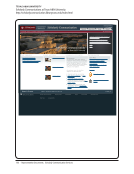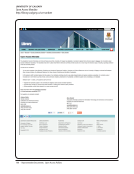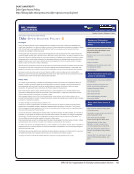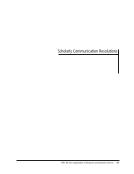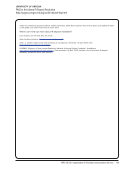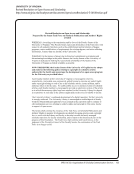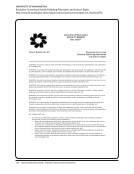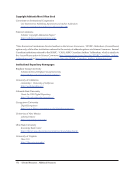58 · Survey Results: Survey Questions and Responses
27. If the success of the library’s SC services has been evaluated, please briefly explain how the data
you’ve collected has influenced your library’s activities, for example modifying, dropping, or
adding any services, identifying underserved constituents in your patron base, etc. N=7
Based on survey results, the library will investigate implementing new services for OA monograph publishing, print on
demand, and improving digital preservation (already a priority for the library). Survey results also indicate differences
in priorities/interests based on academic discipline, providing the basis for targeted information resources and training/
background for SC employees and subject liaison librarians when working with teaching faculty.
Because participation and use of the IR is high, we continue to support it.
Survey results are used to plan educational events and judge interest in particular topics.
Update and develop new services, particularly online tools, multimedia, etc.
We are pleased by information in the survey of faculty in relation to awareness of the open access policy but plan to
increase marketing to increase awareness ratings even further. We redesigned our scholarly publishing website using
input from user experience testing. We have continually modified outreach methods, particularly in relation to the open
access policy, based on anecdotal information gathered about responses and on interviews with department heads.
We have reviewed statistics of all of our services — institutional repository, lecture recording service. The lecture
recording service is very popular. We have also conducted an assessment regarding research data needs on campus.
We use the reports from participants in workshops and results from discussions with constituents to develop new kinds
of programs and to market current services. We track different kinds of publication, such as open access publication, to
see where activity is greatest, to help in focusing marketing efforts. Input from liaison librarians helps us develop subject
appropriate approaches. We use data from the “bibliographer’s annual report” to develop programs and to identify
faculty speakers on topics such as trends in publishing.
Impact of SC Leadership and Services
28. Please indicate which demonstrable outcomes have resulted from your library’s or institution’s SC
efforts and services. Check all that apply. N=54
Authors N=49
Authors submit work to the institutional repository 39 80%
Authors seeking assistance with questions related to authorship have increased since 2007 32 65%
Authors comply with funding mandates (NIH, NSF) 29 59%
Authors use Creative Commons/Science Commons licenses for their work 21 43%
Authors increasingly publish in Open Access journals 20 41%
Authors use copyright addenda 17 35%
Authors submit work to subject or disciplinary repositories 15 31%
Authors have declined to publish in or edit particular journals 13 27%
Other author outcome 13 27%
27. If the success of the library’s SC services has been evaluated, please briefly explain how the data
you’ve collected has influenced your library’s activities, for example modifying, dropping, or
adding any services, identifying underserved constituents in your patron base, etc. N=7
Based on survey results, the library will investigate implementing new services for OA monograph publishing, print on
demand, and improving digital preservation (already a priority for the library). Survey results also indicate differences
in priorities/interests based on academic discipline, providing the basis for targeted information resources and training/
background for SC employees and subject liaison librarians when working with teaching faculty.
Because participation and use of the IR is high, we continue to support it.
Survey results are used to plan educational events and judge interest in particular topics.
Update and develop new services, particularly online tools, multimedia, etc.
We are pleased by information in the survey of faculty in relation to awareness of the open access policy but plan to
increase marketing to increase awareness ratings even further. We redesigned our scholarly publishing website using
input from user experience testing. We have continually modified outreach methods, particularly in relation to the open
access policy, based on anecdotal information gathered about responses and on interviews with department heads.
We have reviewed statistics of all of our services — institutional repository, lecture recording service. The lecture
recording service is very popular. We have also conducted an assessment regarding research data needs on campus.
We use the reports from participants in workshops and results from discussions with constituents to develop new kinds
of programs and to market current services. We track different kinds of publication, such as open access publication, to
see where activity is greatest, to help in focusing marketing efforts. Input from liaison librarians helps us develop subject
appropriate approaches. We use data from the “bibliographer’s annual report” to develop programs and to identify
faculty speakers on topics such as trends in publishing.
Impact of SC Leadership and Services
28. Please indicate which demonstrable outcomes have resulted from your library’s or institution’s SC
efforts and services. Check all that apply. N=54
Authors N=49
Authors submit work to the institutional repository 39 80%
Authors seeking assistance with questions related to authorship have increased since 2007 32 65%
Authors comply with funding mandates (NIH, NSF) 29 59%
Authors use Creative Commons/Science Commons licenses for their work 21 43%
Authors increasingly publish in Open Access journals 20 41%
Authors use copyright addenda 17 35%
Authors submit work to subject or disciplinary repositories 15 31%
Authors have declined to publish in or edit particular journals 13 27%
Other author outcome 13 27%








































































































































